Managing Funeral Traffic with Proper Signage
Funeral no parking signs are specialized traffic management tools designed to reserve parking spaces and maintain order during funeral services. When searching for these essential items, here's what you need to know:
| Funeral No Parking Sign Essentials | Details |
|---|---|
| Standard Size | 18" x 18" (sign face) |
| Height When Mounted | 52" overall |
| Common Materials | Heavy-duty 18-gauge steel with baked enamel finish |
| Popular Options | Double-sided, portable/foldable, customizable text |
| Typical Cost | $47.99-$179.95 depending on quality and features |
| Where to Place | Funeral homes, churches, procession routes, cemeteries |
Funeral services require careful coordination of many moving parts, and proper traffic management is often overlooked until problems arise. These specialized signs serve multiple critical purposes: they reserve essential spaces for funeral vehicles, create clear pathways for the procession, and help maintain the dignified atmosphere that families expect during their time of grief.
Unlike standard parking signage, funeral-specific versions typically feature distinctive designs, temporary mounting solutions, and clear messaging that respects the solemnity of the occasion. The best options combine visibility, durability, and ease of deployment—allowing funeral directors to focus on the families they serve rather than traffic management.
I'm Mortuary Cooler, a national supplier of funeral equipment with extensive experience helping funeral directors select appropriate signage for services of all sizes. Having supplied countless funeral no parking signs to professionals across the country, I understand the practical requirements for effective traffic management during memorial events.
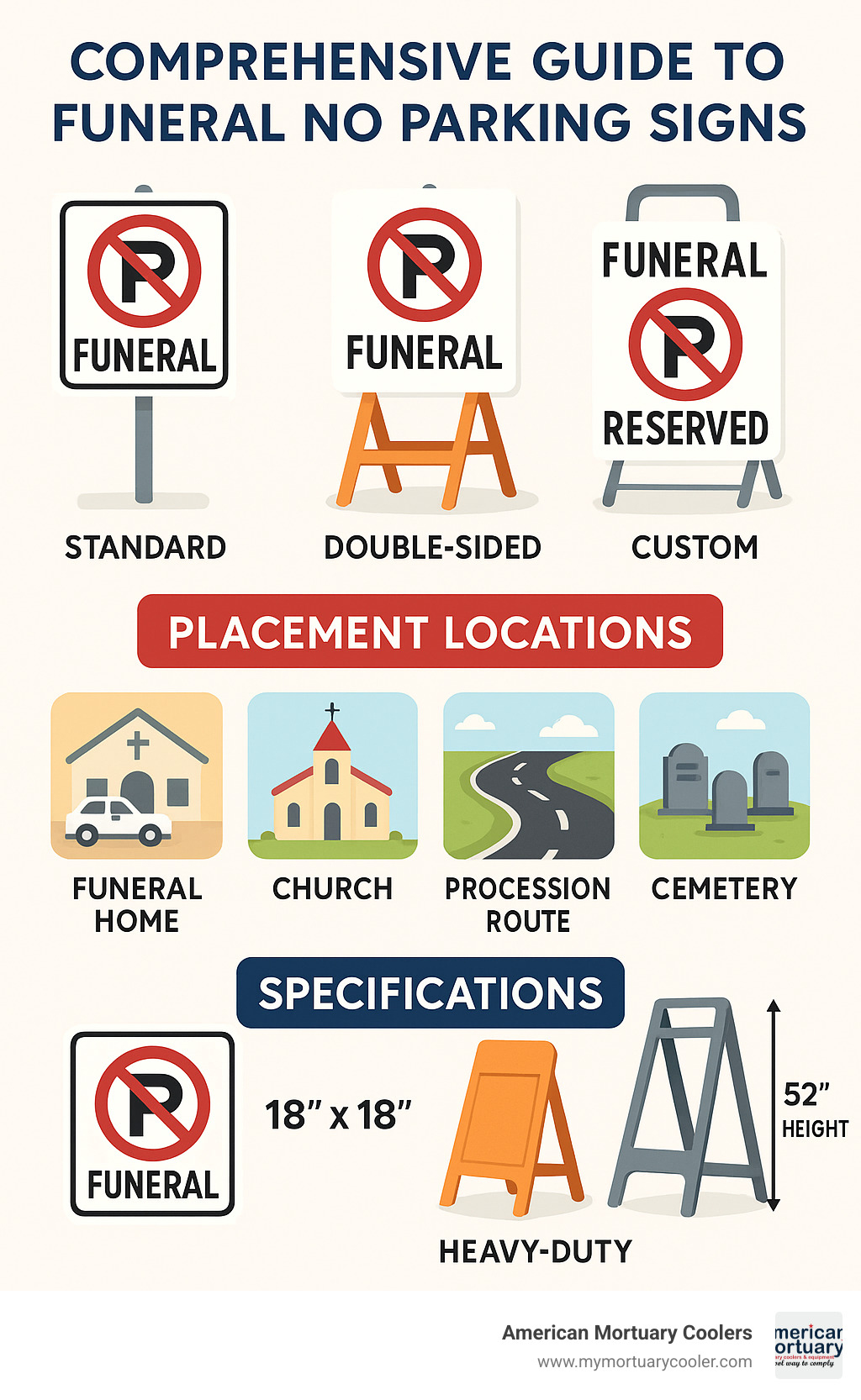
Relevant articles related to funera no parking sign:
Defining the "Funeral No Parking Sign"
A funeral no parking sign is more than just a metal placard—it's a thoughtful tool that creates space for grief and remembrance during life's most difficult moments. These specialized signs temporarily transform ordinary streets and parking areas into dignified spaces reserved for those participating in memorial services.
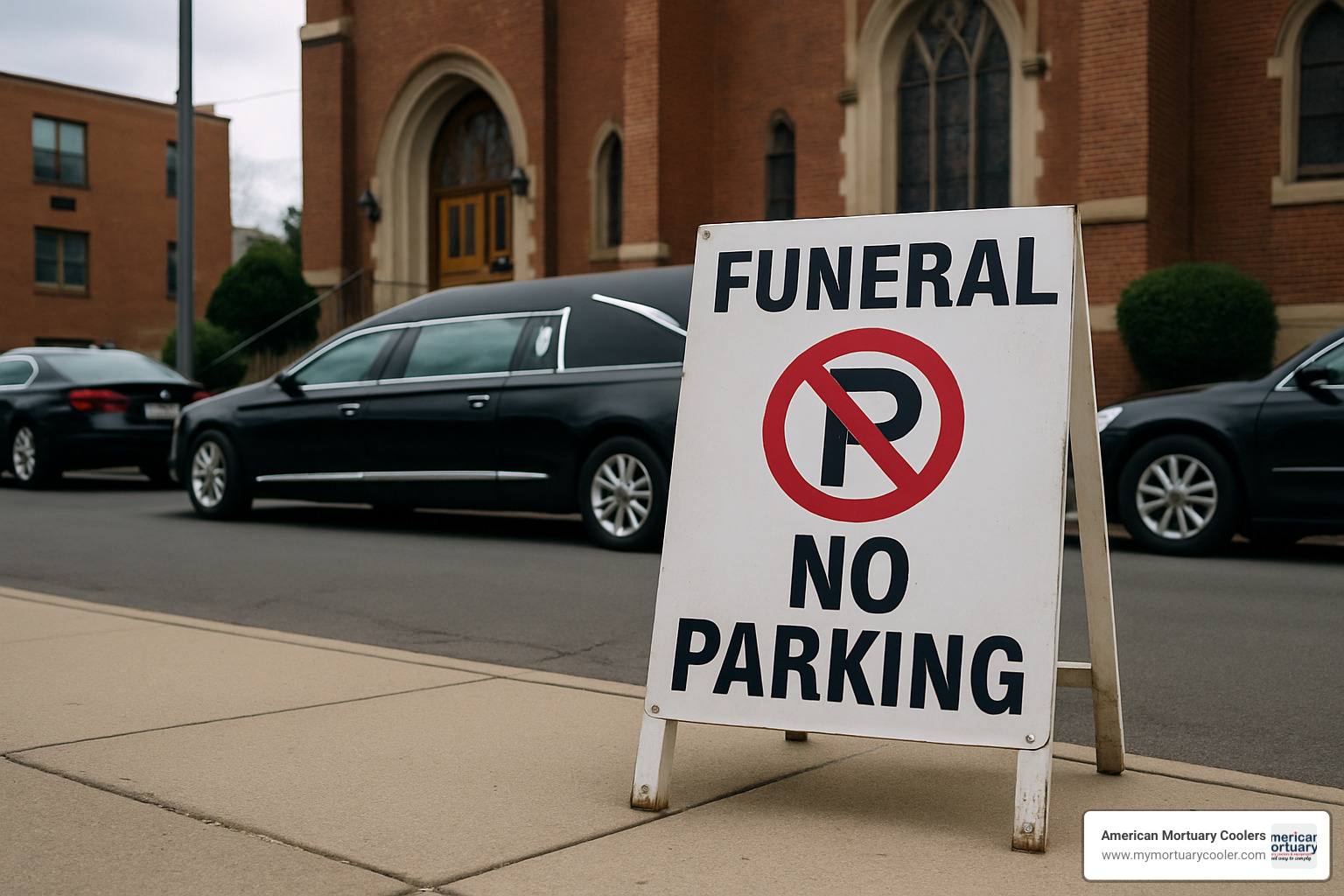
When a family is navigating the fog of loss, the last thing they need is parking stress or traffic confusion. These signs create clear boundaries that protect the procession's pathway and reserve crucial spaces for hearses, limousines, and family vehicles. They establish a buffer zone that helps maintain the dignity everyone deserves during these solemn occasions.
As one Tennessee funeral director who uses our products told me, "These signs aren't just about parking—they're about creating respect. When the community sees them, they understand something important is happening here."
Key purpose of a "Funera No Parking Sign"
The funeral no parking sign quietly performs several essential services during memorial events.
Crowd management becomes intuitive when proper signage reserves spaces directly in front of venues. This ensures immediate family members aren't forced to walk long distances while carrying their emotional burden.
Maintaining solemnity happens naturally when traffic confusion is eliminated. The gentle guidance of these signs helps preserve the dignified atmosphere that grieving families need and deserve.
The signs also handle practical matters like procession organization, creating clear staging areas for vehicles to form without street congestion or confusion. This is particularly important when the funeral includes a multi-vehicle procession to the cemetery.
"The last thing a grieving family needs is to arrive at their loved one's service and find nowhere to park because the spaces were taken by shoppers from the store next door," shared a funeral director who's been using our signs for years. "Good signage prevents these problems before they start."
Safety concerns are addressed too, as clear pathways ensure emergency vehicles can access the area if needed during the service. And in many jurisdictions, proper signage is actually required for legal compliance when temporarily restricting parking.
Common locations for a "Funera No Parking Sign"
The gentle guidance of funeral no parking signs appears in several key locations during memorial events.
Outside funeral homes, they stand sentinel along entrance driveways, near main doors, and in family parking areas. They create a clear path for the initial gathering, where emotions often run highest.
At churches and houses of worship, these signs transform ordinary curbs into organized spaces for family arrival, with special attention to drop-off points and hearse staging areas. The familiar sight of these signs signals to regular churchgoers that today's service requires extra consideration.
Cemetery pathways become more navigable with proper signage, particularly along processional routes and near gravesites. Here, the signs help manage what can otherwise become challenging parking situations on narrow cemetery roads.
City streets that form part of the procession route benefit tremendously from these guides, especially at narrow passages or busy intersections where normal traffic might otherwise cause delays or disruptions.
Even reception venues become more welcoming when signs clearly mark entrances and reserve areas for family or catering vehicles.
"We've found that having a standard deployment plan for each type of service saves tremendous time," explains our operations manager who works with funeral homes across the Southeast. "For church services, we know we'll need at least four signs—two for the hearse and family limousines, and two more for immediate family parking."
The thoughtful placement of these signs is part of the invisible care that good funeral professionals provide—creating order during chaotic times and space for grief when it's needed most.
Funeral vs. Standard No Parking Signs: What's Different?
When you pull up to a funeral service, those special signs reserving spaces aren't just regular no parking signs with a new label. They're actually quite different, designed specifically with the solemn nature of memorial events in mind.
| Feature | Standard No Parking Sign | Funeral No Parking Sign |
|---|---|---|
| Color Scheme | Red/white/black | Often black/purple/silver or subdued colors |
| Wording | "No Parking" or "No Parking Any Time" | "Funeral No Parking," "Funeral Parking Only," or customized with family name |
| Portability | Usually permanently mounted | Typically portable, foldable, or temporary |
| Visibility | Single-sided | Often double-sided for maximum visibility |
| Materials | Heavy-gauge steel, aluminum | Lightweight steel, resin, or plastic for easy transport |
| Mounting | Permanent pole installation | Temporary A-frame, stake, or weighted base |
| Customization | Minimal | Often customizable with funeral home branding or service details |
| Enforcement | Legally binding | May be advisory depending on local regulations |
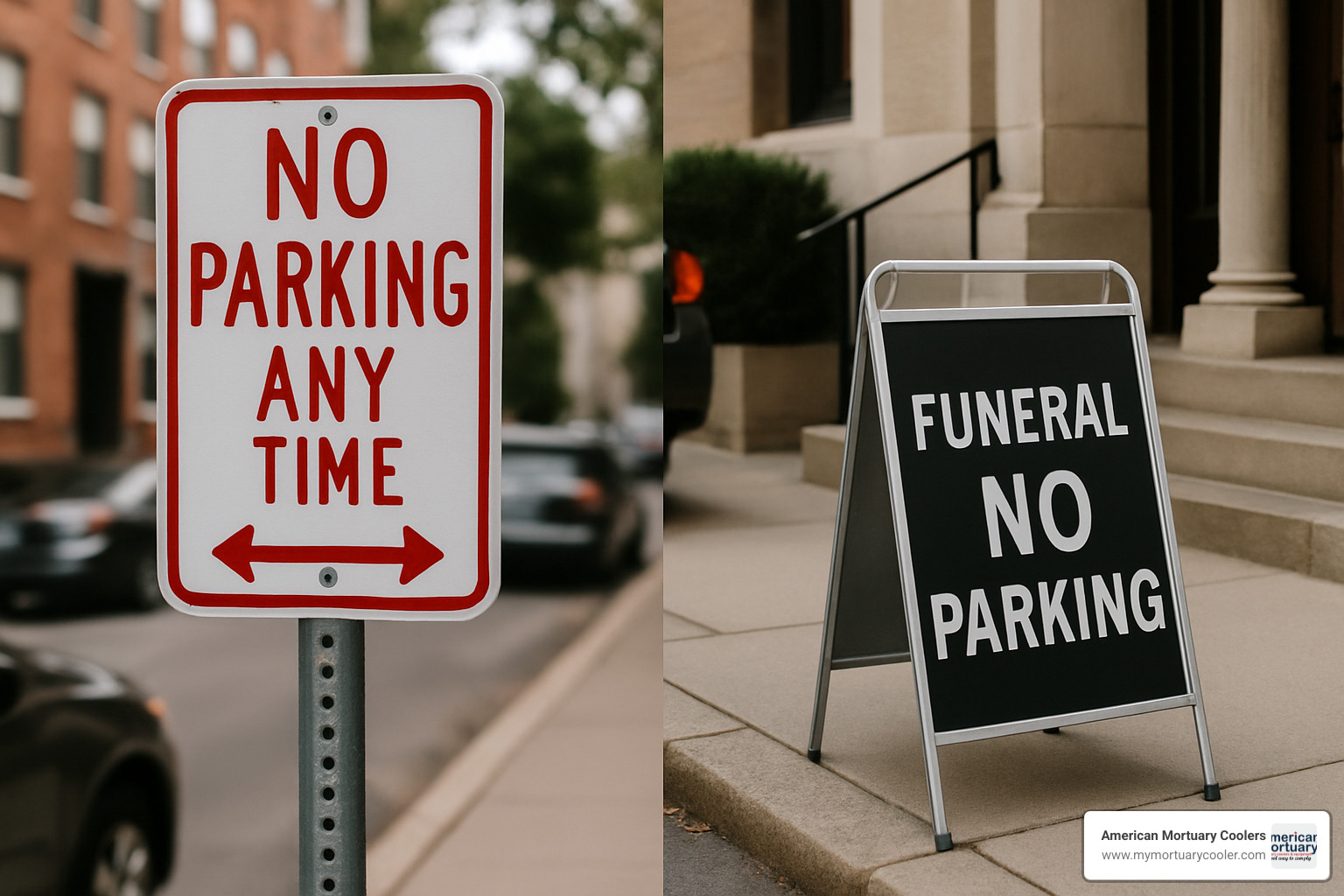
Where standard no parking signs are built to last for years bolted to a permanent pole, funeral no parking signs are crafted for easy setup and removal. They're designed to serve their purpose for a few hours and then be tucked away until the next service. The standard signs follow strict government guidelines from the Manual on Uniform Traffic Control Devices, while funeral signs prioritize dignity, respect, and practical temporary use.
Design cues that signal 'funeral'
You can spot a funeral no parking sign from a distance, even before reading the text. The color palette tends toward more dignified, subdued tones – often black backgrounds with white or silver lettering, sometimes with touches of purple, a color traditionally associated with mourning.
The typography feels more formal too. Instead of the bold, no-nonsense lettering on standard traffic signs, funeral signs often use more neat, serif typefaces that convey respect. Many incorporate subtle symbolic elements like gentle floral patterns or tasteful religious symbols appropriate to the family's tradition.
Even the wording takes a gentler approach. Rather than the blunt "NO PARKING," you might see "Funeral No Parking—Please Respect Family Privacy" or "Reserved for Funeral Procession." This softer messaging acknowledges the emotional context while still clearly communicating the need to keep spaces clear.
"The signs are often the first thing visitors see," one of our funeral director clients told me. "They set the tone for the entire service, so they should reflect the dignity of the occasion."
Materials built for single-day events
Since funeral services typically last just hours, not years, the materials used are specifically chosen for this temporary use:
Most funeral no parking signs weigh under 5 pounds, making them easy for staff to carry and position quickly. Despite their lightweight construction, they're cleverly designed with wider bases or stakes to stay put even in a breeze.
Foldable designs are particularly popular among our funeral home customers. A-frame styles can be stored flat in the back of a vehicle and quickly popped open when needed. They stand independently on sidewalks or lawns without requiring any installation tools.
Weather-resistance is still important, though. Quality signs feature baked enamel finishes on metal components or UV-resistant coatings on plastic parts. After all, services happen year-round in sunshine, rain, and snow.
One funeral director in Milwaukee shared with us, "We invested in quality folding signs three years ago. They've been through hundreds of services in everything from summer heat to winter blizzards. The families appreciate the professional touch, and my staff appreciates how easy they are to transport and set up."
Unlike permanent signs that require concrete footings, funeral signs use temporary solutions like weighted bases, rubber-tipped legs, or simple stakes that can be pushed into softer ground. This allows for flexible placement exactly where needed for each unique service.
Specifications & Customization Options You'll Need
Choosing the right funeral no parking signs is about finding the perfect balance between functionality and dignity. After supplying hundreds of funeral homes nationwide, we've learned exactly what specifications make these signs most effective during those important moments when families need everything to run smoothly.
Popular sizes, shapes & weights
When it comes to the physical characteristics of your signs, several options have proven most practical for funeral services:
Most funeral directors prefer standard 18" x 18" square sign faces, which provide excellent visibility without becoming unwieldy. When mounted on stands, these typically reach 48" to 52" in height—the sweet spot for driver visibility while maintaining stability even on breezy days.
The lightweight A-frame or "tent" style signs have become increasingly popular because they're so practical. When set up, they measure about 24.5" × 18" × 6.5", creating a stable presence on sidewalks or grassy areas. What makes them truly valuable is their ability to fold nearly flat for storage—about 1" thick—making them easy to tuck away in your service vehicle or supply closet.
Weight is another crucial consideration. Most of our clients prefer signs in the 3-5 pound range, allowing staff to easily carry multiple units at once. For windier locations, heavier 8-12 pound options provide extra stability, though they require a bit more muscle to transport.

"Don't overlook storage needs," advises one of our Tennessee funeral directors. "We learned this the hard way after purchasing beautiful signs that wouldn't fit in our supply closet. Folding models are a godsend when space is tight."
Adding logos, colors & text
Your funeral no parking signs can—and should—reflect your funeral home's professionalism and attention to detail. Customization options range from simple to sophisticated:
The most requested standard messages include phrases like "Funeral No Parking," "Funeral Parking Only," and "Reserved for Funeral Procession." Many of our clients have found that adding "Please Respect Funeral Privacy" creates a more compassionate tone that visitors tend to honor.
Custom text possibilities truly set professional signs apart. At American Mortuary Coolers, we regularly create signs featuring funeral home names and logos, which not only look more professional but subtly reinforce your brand during community events. Some of our most thoughtful clients even order signs with space to add family names for more personalized services.
While classic black backgrounds with white lettering remain the gold standard, many funeral homes are exploring custom colors that complement their branding. Our Southeast clients often prefer traditional black and silver schemes, while those in the Southwest sometimes request more subtle earth tones.
The material you choose directly impacts both appearance and longevity. Economy corrugated plastic signs with vinyl lettering typically last 2-3 years with regular use. Our standard 18-gauge steel signs with baked enamel finish provide excellent 5-7 year durability, while premium aluminum signs with reflective lettering can serve your facility for 10+ years, with the added benefit of night visibility.
Double-sided printing has become nearly standard, ensuring your message is visible from both directions. Though it adds about 15-20% to the cost, the improved functionality makes this a worthwhile investment that prevents confusion and keeps traffic flowing smoothly.

An interesting trend we've noticed from our Dallas service area is growing interest in custom funeral cones with personalized sleeves. These bright orange 18" or 28" traffic cones can be fitted with neat black sleeves reading "Funeral Parking Only," creating a distinctive and highly visible alternative to traditional signs.
"We've found the cone sleeves particularly useful for creating a dignified pathway from curbside to entrance," shares one of our long-time clients. "They guide mourners exactly where they need to go without feeling imposing."
Regulations, Enforcement & Responsibility
The world of funeral no parking signs comes with a patchwork of regulations that change from one town to the next. This can create headaches for funeral directors who just want to ensure families have proper parking during an already difficult time.
Who places and removes the signs?
In most cases, it's the funeral home staff who handle the entire sign process. They'll arrive early, set up the signs in strategic locations, and then collect them after the service concludes. This hands-on approach ensures everything is timed perfectly with the day's events.
"We treat sign placement as seriously as any other element of service preparation," shares one of our Tennessee clients. "It's part of creating that smooth, dignified experience families deserve."
In some cities, particularly in the Northeast, you'll find a more official approach. Municipal workers from public works or traffic departments will place the signs for you—but you'll need to submit paperwork 24-48 hours ahead of time with exact locations and service duration.
For smaller, more intimate services, especially in rural communities, family members sometimes take on this responsibility themselves. When we hear about this happening, we always recommend providing clear guidance on placement and local rules to avoid any complications.
Many houses of worship that regularly host funeral services maintain their own collection of parking signs. Their staff handles placement for events at their facilities, having developed efficient systems through years of experience.
Timing matters tremendously. Place signs too early, and they might be ignored or unnecessarily inconvenience neighbors. Too late, and you'll find parking spaces already filled. Our best practice recommendation: 1-2 hours before services in busy urban areas, and 30-60 minutes in quieter locations.
Are violations ticketable?
The real-world enforceability of funeral no parking signs typically falls into one of three categories:
Legally enforceable with permits: In major cities like New York, Chicago and Los Angeles, funeral homes can obtain temporary parking permits that carry the full weight of law. Vehicles ignoring these restrictions can be ticketed or towed. New York City's clergy permits are a good example, allowing legal temporary restrictions during religious services, including funerals.
Advisory with police cooperation: Many suburban and mid-sized communities treat these signs as technically advisory rather than legally binding. However, local police departments often develop good working relationships with funeral homes and will provide enforcement assistance as a professional courtesy.
Purely advisory: In some areas, particularly smaller towns without specific funeral parking ordinances, signs serve simply as a polite notice with no enforcement mechanism. Their effectiveness comes down to community respect and cooperation.
To understand where your location falls, reach out to your local traffic department, review municipal codes, chat with other funeral directors in your area, and build relationships with local law enforcement who might provide assistance.
Even when signs are legally enforceable, most funeral directors prefer avoiding confrontation during services. As one director from Columbia told us, "We have the legal right to have cars towed, but we try to avoid creating more distress during a family's time of grief. Our approach is preventative—early sign placement and staff monitoring—to gently redirect before problems develop."
This balanced approach recognizes that while the technical rules matter, the human element of funeral service always comes first. After all, funeral no parking signs exist to make a difficult day a little easier, not to create additional stress for anyone involved.
Placement, Traffic Flow & Best-Practice Checklist
Effective deployment of funeral no parking signs is both an art and a science. After years of helping funeral homes across the country manage their services, we've learned that thoughtful placement creates a seamless experience for grieving families and their guests.
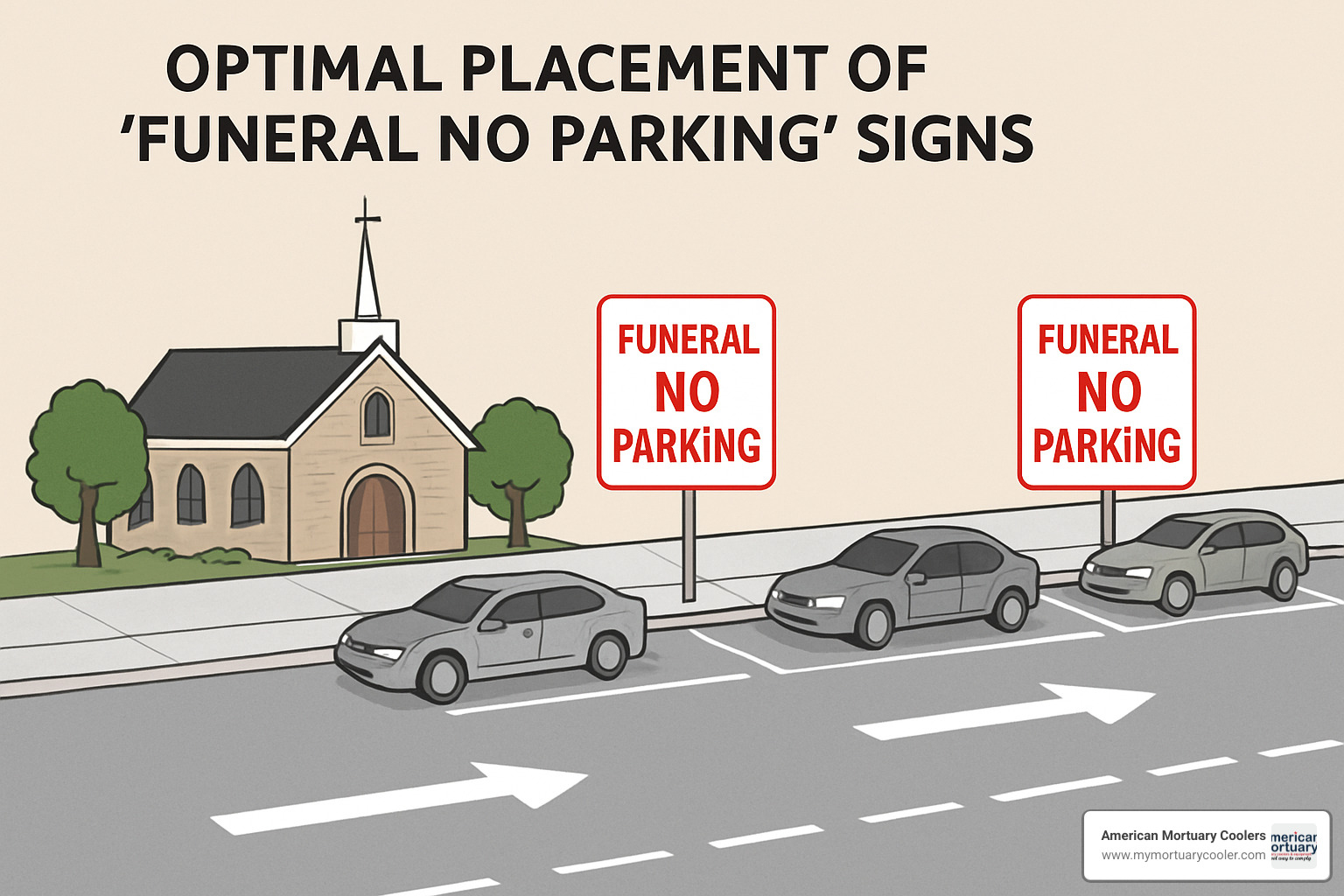
Think of your signage as silent ushers—they guide, direct, and create order without saying a word. The right placement ensures hearses and family vehicles have clear access, processions form smoothly, and the solemn dignity of the occasion remains undisturbed.
10-point onsite checklist
I remember visiting a service in Nashville where the funeral director had everything timed like clockwork. "The secret," he told me, "is setting up those signs with purpose—not just sticking them anywhere." His approach mirrors what we've found works best across the country:
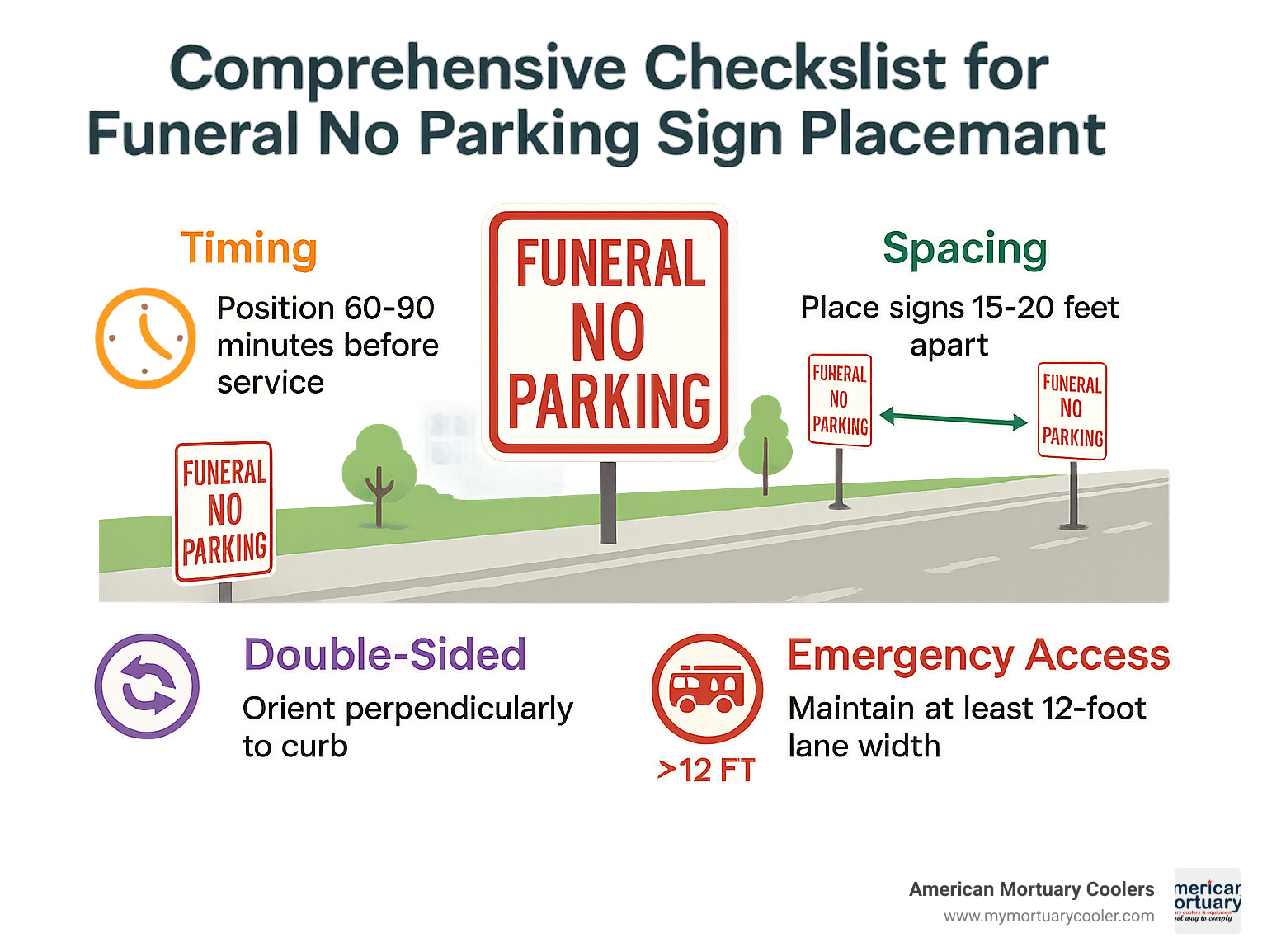
Timing matters immensely. In busy downtown areas, you'll want signs positioned 60-90 minutes before the service begins. For quieter locations, 30-60 minutes usually suffices. This gives you enough cushion to secure spaces without needlessly blocking public parking.
Spacing your signs correctly creates a clear visual boundary. We typically recommend placing them 15-20 feet apart along curbs. For larger services, try "bookending" the reserved section with signs at each end, then filling in between as needed.
Double-sided signs should face traffic from both directions. It seems obvious, but I've seen many funeral homes position them flat against the curb, cutting visibility in half. Position them perpendicular to the street for maximum impact.
Height is crucial for visibility. The sweet spot is 36-42 inches above ground level—high enough to be seen over parked cars but still in a driver's natural line of sight. Too low and they're missed; too high and they're overlooked.
Always maintain proper clearances from driveways, fire hydrants, and crosswalks—at least 5 feet. This isn't just courteous; it's often legally required and ensures emergency access remains unobstructed.
Weather can be your worst enemy or a minor inconvenience depending on your preparation. In Chicago and other windy cities, our clients swear by weighted bases or sandbags. For snowy regions, position signs further from the curb so they're still visible after plowing.
Evening services require extra consideration. Standard signs often disappear into the darkness. Consider adding reflective elements or small battery-operated lights to ensure they remain visible after sunset.
Accessibility should never be compromised. Position signs to maintain clear pathways for wheelchairs and those with mobility challenges. The last thing a grieving family needs is an accessibility issue during an already difficult time.
Emergency vehicle access is non-negotiable. Always preserve a lane width of at least 12 feet. As one funeral director in Memphis told me, "In 30 years, I've had three medical emergencies during services. That extra space made all the difference."
Removal is just as important as placement. Assign specific staff responsibility for collecting signs immediately after the service or procession departs. Leaving them up longer than necessary creates community frustration and diminishes their impact for future services.
"These principles aren't just theoretical," our Southeast Region manager often reminds new funeral directors. "When signs are thoughtfully positioned, families can focus entirely on honoring their loved one rather than worrying about logistics."
For funeral homes in areas with challenging weather, investing in durable signage is particularly important. Our heavy-duty 18-gauge steel signs with baked enamel finish have weathered countless Midwest winters, while our lightweight alternatives serve perfectly in milder climates like the Southeast.
Even perfect sign placement works best when paired with clear communication. The most successful services we've observed include parking instructions in service information packets and have staff available to direct traffic during peak arrival times. These small touches help transform a potentially chaotic element into a seamless part of a dignified farewell.
Cultural Approaches & Creative/Humorous Alternatives
The world of funeral no parking signs is surprisingly diverse, reflecting different cultural attitudes toward death, mourning, and public space. From solemn traditional designs to occasionally lighthearted alternatives, these signs tell us something about how different communities approach end-of-life ceremonies.
Walking through the streets of Tokyo, you might notice their funeral parking signs look quite different from American versions. Japanese signs typically use more symbolic imagery and subdued colors that reflect their cultural emphasis on quiet dignity. Meanwhile, in New Orleans, where jazz funerals celebrate life as much as mourn death, parking signs might incorporate musical motifs or vibrant colors.
When humor is appropriate—and when it's not
Most funeral services call for respectful, dignified signage. But there are times when a touch of humor might actually be the perfect choice.
For "celebration of life" services, especially those planned by the deceased before their passing, lighthearted signage can perfectly match the tone of the event. I'll never forget the family in Nashville who requested custom signs reading "Rock Star Parking Only — Final Tour in Progress" for a beloved musician's memorial. The signs brought smiles to attendees' faces, exactly as the deceased had hoped.
When humor works well:
- At explicitly celebratory services
- When the deceased left instructions for a lighter tone
- In cultural contexts where celebration is part of mourning
- When the family specifically requests it
But tread carefully. What seems amusing to some might deeply offend others during a vulnerable time. As my colleague James at our Memphis branch always says, "When in doubt, err on the side of dignity and respect."
Humor should be avoided during traditional religious services, after unexpected or tragic deaths, when serving families from cultures with strict mourning protocols, or when there's any chance the humor could be misinterpreted by the general public.
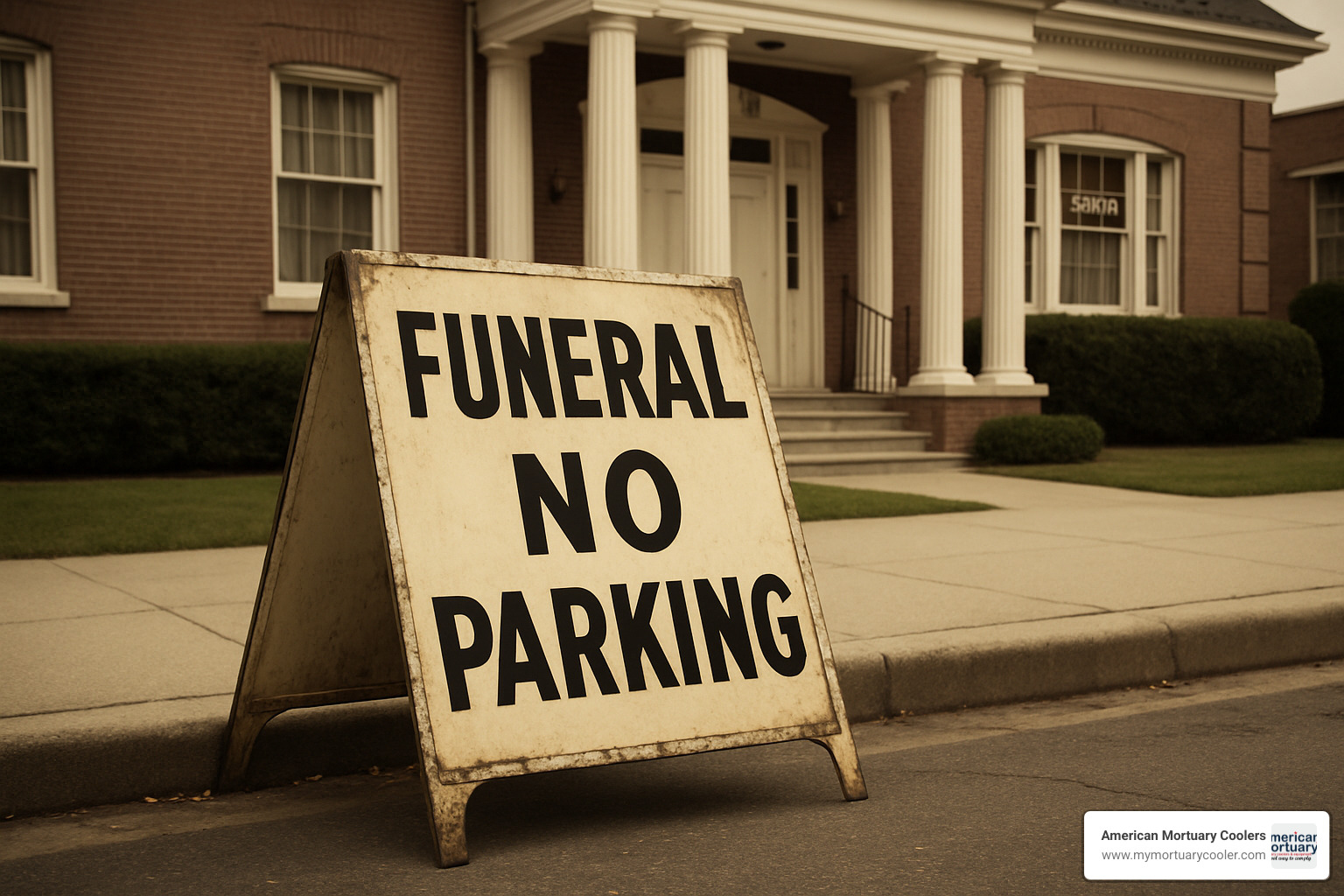
Collectible & antique funeral signs
Beyond their practical function, vintage funeral no parking signs have become fascinating collectibles that offer a window into the history of funeral practices. These pieces of funeral Americana tell stories about how we've approached death and mourning through the decades.
Mid-century metal signs from the 1940s-1960s are particularly prized by collectors. These tent-style signs featured distinctive typography, minimal design elements, and were built from heavier-gauge metal than today's versions. The hand-painted or early silk-screened lettering has a character that mass-produced modern signs simply can't match.
Regional differences make collecting these signs particularly interesting. Northeastern vintage signs tend toward formality with more text, while Southern examples often incorporate religious symbols. Western states produced signs with larger text for visibility across wider streets—practical differences that reflect regional funeral customs.
The distinctive aesthetic of vintage funeral signs has even inspired a market for decorative reproductions. These resin replicas serve as conversation pieces in homes, offices, and seasonal Halloween displays. At auction, original vintage funeral parking signs in good condition typically fetch $75-$200, with rare examples or those from well-known establishments commanding even higher prices.
Several funeral homes we work with display historical signage as part of their facility's heritage. As one of our Johnson City clients shared, "We display our funeral home's original 1932 parking signs in our history corner. Families often comment on how the signs connect them to generations of service in our community."
For funeral directors interested in creating a similar historical display, we recommend sourcing authentic vintage signs from reputable auction houses that specialize in funeral memorabilia. A small display explaining how signage reflects the evolution of funeral practices can create meaningful connections with the families you serve.
If you're fascinated by unusual signage beyond the funeral industry, you might enjoy this collection of the 22 funniest signs from around the world—though we recommend saving these for contexts well outside memorial services!
Frequently Asked Questions about Funeral Parking Signs
Are temporary funeral signs legally binding?
The legal status of funeral no parking signs exists in a fascinating gray area that varies widely depending on where you live. In major metropolitan areas like New York or Chicago, funeral homes can often secure temporary permits that give these signs the full weight of law—meaning yes, that car parked in front of the hearse could actually get ticketed or towed. New York City specifically offers clergy permits designed for religious services, including funerals, that temporarily transform ordinary curb space into legally protected funeral zones.
The picture changes dramatically as you move to suburban communities. Here, these signs often operate more on community respect than legal authority. Local police departments frequently honor these restrictions as a professional courtesy to funeral homes, even when the signs themselves carry no technical legal authority.
"We've found that building relationships with local officers makes all the difference," shares one of our Memphis-area funeral directors. "They understand the importance of what we do and generally help enforce our parking needs, even though our signs aren't officially backed by city ordinance."
In rural areas, funeral no parking signs typically function purely as informational markers, relying entirely on community goodwill rather than any enforcement mechanism. Yet surprisingly, these areas often show the highest compliance rates—a testament to small-town respect for funeral traditions.
For maximum effectiveness regardless of your location, we recommend:
- Placing signs well before services begin (90 minutes is our sweet spot)
- Using professional-quality signage that commands respect
- Having staff available during arrival times to gently redirect any confused drivers
- Checking with your local authorities about available permits that might strengthen your position
How many signs do I need for a typical service?
I'm often asked this question by funeral directors setting up their first complete signage system, and the honest answer is: it depends on your specific needs. The perfect number of funeral no parking signs varies based on several factors including service size, venue location, and urban density.
For intimate gatherings of 25-50 people, you can generally manage with a minimal setup. At the funeral home itself, 2-3 signs strategically placed at the main entrance and family parking area usually suffice. Church services might require 3-4 signs covering the hearse location, family drop-off point, and general reserved areas. Cemetery needs are typically minimal, with just 1-2 signs marking the procession vehicle location.
Medium-sized services with 50-100 attendees naturally demand more coverage. The funeral home setting typically requires 4-5 signs to adequately reserve spaces for immediate family and key vehicles. Church services need 5-7 signs covering approximately 100-150 feet of curb space, while cemetery arrangements call for 2-3 signs to properly organize the procession staging and family parking.
Large memorial events with over 100 attendees require the most comprehensive approach. Funeral homes should deploy 6-8 signs covering multiple entrance points and extended parking areas. Churches might need 8-12 signs, potentially spanning multiple street sections. Cemetery services require 4-6 signs to manage extended procession lines and multiple parking zones.
"When we first opened our second location, we thought we could get by with just transferring signs between facilities," recalls a Nashville funeral director we work with. "That lasted exactly one week before we realized the logistical nightmare it created. Now each location maintains its own complete set, and the peace of mind is worth every penny."
For established funeral homes conducting services daily, we recommend maintaining an inventory of at least 12-15 signs. This provides enough flexibility to handle overlapping services or unexpected situations without scrambling.
Can I rent instead of buy?
While purchasing your own set of funeral no parking signs represents the most common approach in our industry, rental options do exist and might make sense in certain situations. If your facility handles infrequent services or occasionally needs specialized signage for unusually large events, renting could be worth exploring.
Several sources offer rental options, each with distinct advantages. Event supply companies typically stock generic "Event Parking" signs that can serve in a pinch, though they lack the dignified appearance of proper funeral signage. Traffic management firms provide professional-grade options, sometimes with staff to deploy them, but at premium prices. Some municipalities offer sign rental programs for permitted events, though availability varies widely. In some regions, funeral supply cooperatives have emerged, allowing smaller funeral homes to share resources.
The rental equation comes with several considerations beyond just the daily rate of $5-15 per sign. Customization options tend to be limited compared to signs you own outright. Availability can become problematic, especially during peak funeral seasons when multiple facilities need extra signage simultaneously. And don't overlook the logistical challenges—someone from your staff will need to handle pickup and return, often during already busy service days.
For established funeral homes, purchasing typically represents the wiser long-term investment. A quality set of five funeral no parking signs generally costs between $240-300 and will serve your facility faithfully for 5+ years with proper care. This brings your per-use cost down to just a few dollars—significantly less than rental rates over time.
One South Carolina director shared his experience: "We started by renting signs whenever we needed them, but after tracking our expenses for a year, the math became obvious. Ownership paid for itself in under 8 months, plus we gained the convenience of having perfectly matched signs always ready when families needed them."
At American Mortuary Coolers, we understand that initial equipment costs can strain funeral home budgets. That's why we offer flexible financing options that make sign purchases more manageable, with plans starting at three payments of $61.48 for a complete professional-grade sign set. This allows you to acquire the proper tools for serving families with dignity while preserving your operational cash flow.
Conclusion
Effective management of parking and traffic flow remains one of the most overlooked aspects of funeral service coordination. Funeral no parking signs provide a simple yet powerful tool for creating order and dignity during what is often a chaotic and emotional time for families.
At American Mortuary Coolers, we understand that every detail matters when serving families during their most difficult moments. While our primary focus remains on providing the highest quality mortuary cooling and preparation equipment, we recognize that auxiliary supplies like parking signage play a crucial role in the overall service experience.
You know, I've spoken with dozens of funeral directors over the years, and they all tell me the same thing - it's those small details that families remember. A smoothly organized parking situation might seem minor compared to other aspects of a service, but it sets the tone from the moment guests arrive.
Quality signs are an investment in your professional image. Those flimsy, temporary signs that blow over in the slightest breeze? They send a message about attention to detail. Durable, professional-looking signs with weather-resistant finishes not only provide years of reliable service but also project the level of professionalism families expect when entrusting you with their loved ones.
I remember visiting a funeral home in Memphis that had been using the same set of custom signs for nearly a decade. The director told me, "These signs have directed thousands of mourners safely to our services - they've more than paid for themselves in peace of mind alone."
Customization truly improves effectiveness. Signs custom to your specific facility, with appropriate branding and messaging, create a cohesive experience. When families see your logo and consistent design elements throughout their journey - from your website to your building to your parking signs - it reinforces that feeling of being in capable, organized hands.
Following our strategic placement guidelines ensures your signs aren't just present but effective. I've seen too many funeral homes invest in quality signs only to position them poorly. Our 10-point placement checklist helps ensure signs are visible, effective, and compliant with local regulations.
Cultural sensitivity should always guide your choices. A sign that works perfectly for one community might feel inappropriate in another. Understanding the diverse needs of your community helps determine when traditional, contemporary, or occasionally even humorous approaches might be appropriate.
Don't forget about proper storage between services! One of our clients in Chicago built a simple wall-mounted rack in their garage to keep their signs organized and protected. This small step has extended the lifespan of their signage considerably.
Our team across our locations in Tennessee, Georgia, Illinois, South Carolina, Texas, California, New York, and Pennsylvania is here to help you select the right funeral no parking signs for your specific needs. As with all our mortuary equipment, we focus on durable, practical solutions that improve your ability to serve families with dignity and respect.
For more information about our complete line of mortuary equipment and supplies, including our industry-leading mortuary coolers, please contact our customer service team. We're proud to be your partner in providing exceptional care during life's most challenging moments.


















